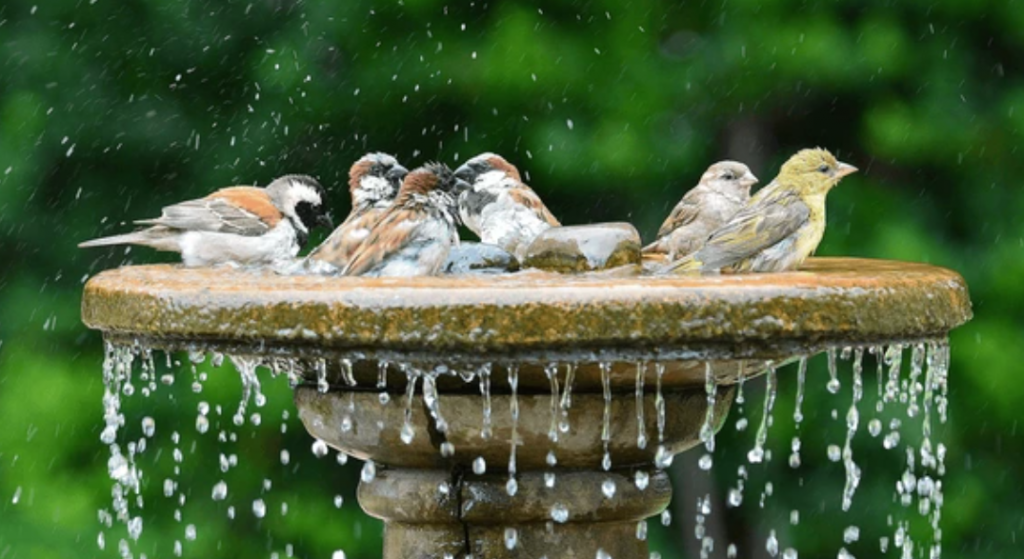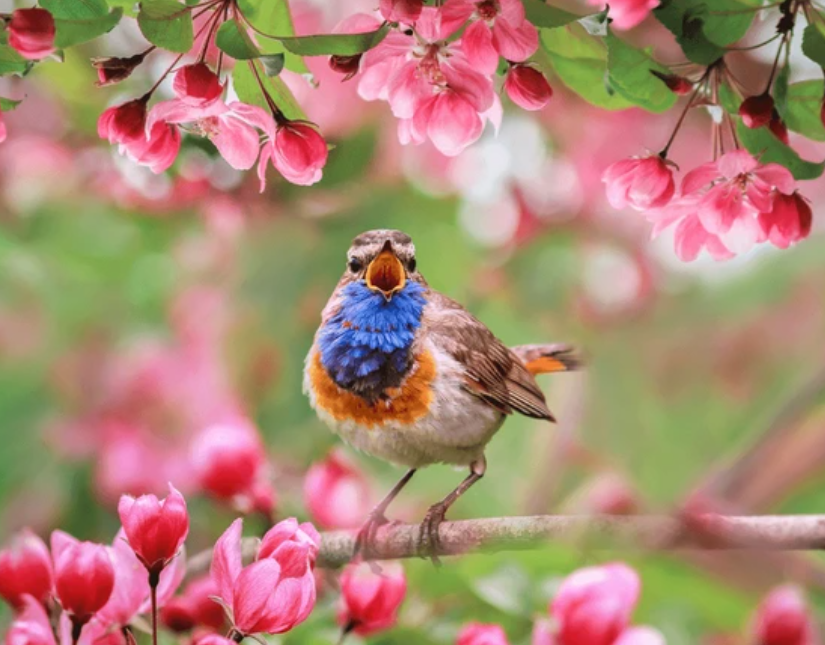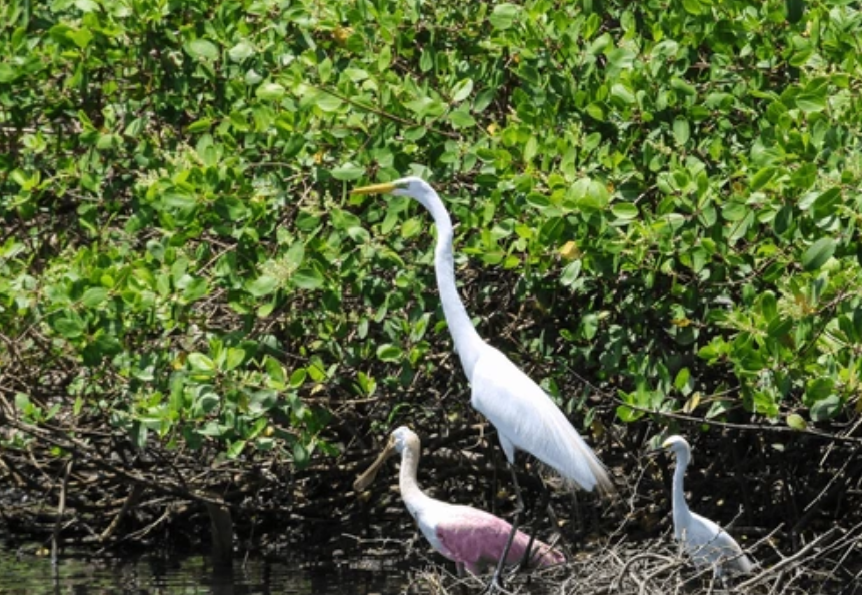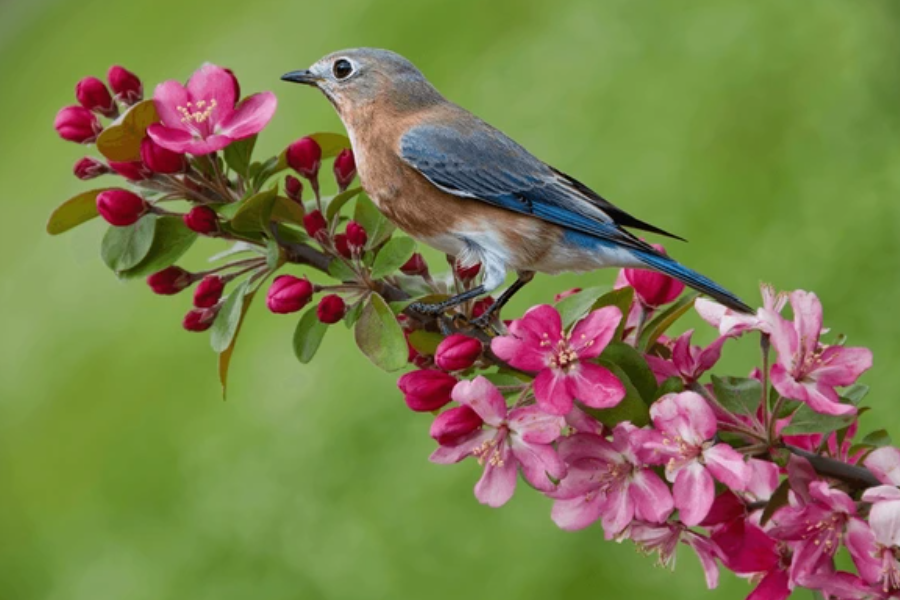Birdbaths & Beyond (Gardens Designed for Birds)


Creating gardens that combine birdbaths, feeders and bird-friendly planting plans significantly enhances the bird-watching experience. The variety of bird species that visit, each with its unique behaviors and characteristics, provides endless entertainment and educational opportunities, as well as a peaceful and rewarding connection to nature.
By Eric Herman
A well-designed garden that attracts birds can provide near constant opportunities to indulge the whimsical enjoyment that our fine-feathered friends bring with them. Observing birds as they feed, bathe, and interact with each other fosters a deep and delightful connection with nature and for many, an abiding sense of stewardship for the environment.
For the curious minded amongst us, “birding” can be great fun. The variety of bird species can fill a lifetime of fascination. Birds are wonderfully diverse, often dazzlingly beautiful, or modestly subtle, large and small, they are unique and inspiring in the many ways the adapt to and shape their surroundings.
From a landscape design perspective, the presence of birds can enhance the aesthetic and auditory appeal of any garden, adding life, color, and song to the space. Designing a garden to attract birds involves thoughtful planning and plant selection, effort that is often rewarded by the eager presence of a variety of birds. By incorporating diverse vegetation layers, choosing native plants, and providing essential resources like food (feeders), water (birdbaths), and shelter (plantings), you can create a haven for birds.
Regular maintenance and adaptation to the needs of local bird species will ensure a garden remains a vibrant, bird-friendly destination. The joy of bird watching in such a garden is a rewarding experience for young and old alike, offering both personal satisfaction and a meaningful contribution to local biodiversity. It’s fun you can feel good about and enjoy as along as you have the ability to open your eyes and ears to the wonders of dinosaur descendants.
WATER & FOOD
Combining birdbaths and feeders in your garden is an excellent way to attract a diverse range of birds while creating a vibrant and dynamic avian habitat. By understanding the different types of feeders and their optimal placement, and integrating them thoughtfully with birdbaths, you can create an inviting destination that supports bird populations and enriches the bird-watching experience.
Birdbaths are a particularly effective addition to many gardens, offering both the fascination of bird behavior and pecking order, as well as essential hydration for birds. Birdbaths can transform a simple backyard space into a bustling hub of bird behaviors, resulting in quite the vibrant pageant that you can binge watch on a daily basis.
For birds, oftentimes, the water is where the action is. Observing birds as they drink, bathe, and interact provides endless entertainment that has nothing to do with the internet or television. Birdbaths offer a unique opportunity to observe bird behavior up close, from the meticulous preening of feathers to the playful splashing of water.
Birdbaths are more than simple garden ornaments; they are vital resources that support bird populations and sometimes enrich our lives. Thoughtful design and regular maintenance ensure these features provide a safe and attractive environment for birds, encouraging a diverse array of species to visit.
BIRD BATH DESIGN
Designing a birdbath involves balancing aesthetics with functionality. Birdbaths come in various materials, such as stone, ceramic, metal, and plastic. The choice of material can influence the bath’s durability and maintenance needs.
The structure should include a shallow basin, ideally one-to-two inches deep, to accommodate small birds and reduce the risk of drowning. A textured surface is beneficial as it provides sound footing, preventing birds from slipping. Additionally, incorporating a gentle slope allows birds to comfortably wade in and out of the water.
Placement is another critical factor. Bird baths should be positioned in a shaded area to keep the water cool and near shrubs or trees, providing birds with quick access to cover from predators. Elevated bird baths can also protect birds from ground-dwelling predators.
Types of Birds Attracted
Bird baths attract a wide variety of bird species, each bringing its own charm. Common visitors include:
Songbirds: Robins, finches, and sparrows frequently visit bird baths for drinking and bathing.
Thrushes: Known for their melodious songs, and are fond of splashing in the water.
Woodpeckers: These industrious birds are drawn to birdbaths, particularly in hotter climates where natural water sources may be scarce.
Hummingbirds: While primarily nectar feeders, hummingbirds also appreciate a refreshing dip.
Raptors: Larger bird baths might attract birds of prey like hawks, which use them for drinking.
Designing for Multiple Birds
To accommodate a greater number of birds, consider a larger birdbath with ample space. A multi-tiered courtyard found fountain may be the perfect choice as it can serve the dual purpose of attracting birds and working as a fountain that please the human inhabitants. Multiple tiers or additional smaller baths can also distribute bird traffic, reducing competition and the potential for aggressive behavior.
Including perches and stones within the bath provides resting spots and accommodates birds of various sizes. Ensuring easy access to fresh water in multiple locations around the garden can further encourage a diverse avian population.
Keep in mind that although ponds, streams, waterfall, fountains and even swimming pools may not be designed specifically for birds, almost any body of water will attract feathered denizens of the air.
CARE TAKING
It’s also important to remember that while birdbaths provide significant benefits, they can also pose health hazards if not properly maintained, as is true of any contained body of water. Stagnant water can become a breeding ground for mosquitoes, which can transmit diseases such as West Nile virus.
Unlike other watershapes that are chemically treated, birdbath water should be kept wholesome by regular drain and fill routines. Dirty water can harbor harmful bacteria and parasites that may lead to avian diseases like avian pox or salmonellosis. Regular cleaning and water changes are essential to mitigate these risks.
To ensure a safe and inviting environment, birdbaths should be cleaned and refilled with fresh water every few days. In warmer weather, more frequent changes might be necessary to prevent algae growth and the proliferation of pathogens.
Cleaning involves scrubbing the basin with a brush and mild detergent, followed by a thorough rinse to remove any residue. Again, avoid using harsh chemicals, as these can be harmful to birds.
FEEDER FRENZY
Combining birdbaths and feeders in your garden is an effective way to attract a wide variety of bird species, creating a dynamic and vibrant habitat. This approach not only provides essential resources like water and food but also enhances the overall bird-watching experience for the garden’s human inhabitants and visitors.
Bird feeders come in various designs, each catering to specific types of birds and their feeding habits. Understanding the different types of feeders can help you attract a diverse range of species:
Tube Feeders: These feeders are cylindrical and often have multiple feeding ports. They are ideal for small birds like finches, chickadees, and sparrows. Tube feeders can be filled with seeds, such as sunflower seeds or nyjer.
Hopper Feeders: Resembling small houses, hopper feeders store large amounts of seed that is dispensed as birds eat. They attract a variety of birds, including cardinals, jays, and grosbeaks.
Platform Feeders: These flat, open feeders are versatile and can hold seeds, fruit, or mealworms. They attract ground-feeding birds such as doves, juncos, and sparrows, as well as larger birds like pigeons and crows.
Suet Feeders: Designed to hold suet cakes, these feeders are particularly appealing to woodpeckers, nuthatches, and chickadees, as well as crows and ravens. Suet provides high-energy food, especially important during colder months.
Hummingbird Feeders: These feeders dispense a sugar-water solution and are specifically designed for hummingbirds. Their bright red color helps attract these tiny, nectar-feeding birds.
Accidental Feeders: Be aware that almost any source of moving water combined with some type of basin, meaning the vast majority of fountains, will attract birds, meaning a majority of common fountain types will prove irresistible to many types of birds.
FEEDER PLACEMENT
The placement of bird feeders is crucial for attracting birds and ensuring their safety and comfort. Here are some tips:
Visibility and accessibility: Place feeders in visible locations where birds can easily spot them. Ensure they are accessible and not obstructed by dense foliage.
Safety from predators: Position feeders away from areas where cats or other predators can easily ambush birds. Ideally, feeders should be at least 10-12 feet from dense cover where predators might hide.
Proximity to cover: Birds need nearby cover, such as trees or shrubs, to retreat to if threatened. Placing feeders within 10 feet of such cover can provide birds with a quick escape route while minimizing the risk of predation.
Distance from windows: To prevent bird collisions, place feeders either very close to windows (within 3 feet) or at a safe distance (more than 10 feet away). If feeders are close to windows, birds are less likely to gain the momentum needed to injure themselves if they fly into the glass.
BATH & FEEDER INTEGRATION
Combining birdbaths and feeders effectively requires strategic planning. Placing birdbaths near feeders creates a comprehensive habitat where birds can find both food and water. Here are some key considerations:
Spacing and layout: Position bird baths and feeders within sight of each other but with enough distance to prevent overcrowding. A distance of five-to-10 feet is typically sufficient to allow birds comfortable movement between feeding and bathing areas. Be sure the birdbath is not directly under feeders to avoid contamination from falling seeds and bird droppings.
Variety and diversity: Use a mix of feeder types and birdbaths to cater to different bird species. For example, a shallow bird bath near a platform feeder can attract ground-feeding birds, while a tube feeder and elevated birdbath might appeal to smaller perching birds.
Seasonal adjustments: Adjust the placement and type of feeders and baths seasonally. In winter, consider placing feeders and heated bird baths in sheltered areas to protect birds from harsh weather. In summer, move them to shaded areas to keep water cool and fresh.
GARDEN DESIGN FOR THE BIRDS
Designing a garden to attract birds involves several key principles:
Diverse plant layers: Incorporate multiple layers of vegetation, including ground cover, shrubs, and trees. This vertical diversity mimics natural habitats and provides birds with a variety of foraging, nesting, and shelter opportunities.
Native plants: Use native plants as they are adapted to the local climate and soil conditions. Native plants are more likely to produce the seeds, fruits, and insects that local bird species rely on.
Shelter and nesting sites: Ensure your garden offers adequate shelter and nesting sites, including dense shrubs, trees with sturdy branches, and birdhouses to provide safe spaces for birds to roost and raise their young.
Food sources: Plant a variety of species that provide food throughout the year. This includes plants that produce seeds, berries, nectar, and attract insects.
Avoid pesticides: Minimize or eliminate the use of pesticides and herbicides. These chemicals can be harmful to birds and reduce the availability of insects, which are a crucial food source.
PLANT SELECTION
Choosing the right plants is crucial for creating a garden that attracts and supports birds. Here are some plant categories and specific examples to consider
Starting with trees, it’s helpful to know that most trees attract birds, especially healthy trees that are indigenous or at least well-suited for the climate zone. Trees are a critical component of any bird-friendly garden, providing food, shelter, and nesting sites for a variety of species. Different trees attract different birds depending on the type of seeds, fruits the produce, the species of insects they attract, as well as the shelter they offer. Here are some types of trees that are particularly attractive to birds:
Oak (Quercus): Attracts woodpeckers, blue jays, nuthatches, titmice, and many others. Oak trees produce acorns, a vital food source for many birds. They also host a wide variety of insects, providing ample feeding opportunities for insectivorous birds. The large, sturdybranches are ideal for nesting.
Dogwood (Cornus): Attracts robins, bluebirds, cardinals, waxwings, and warblers. Dogwood trees produce small, fleshy fruits that are highly attractive to many bird species. The flowers attract insects, which in turn attract insectivorous birds.
Serviceberry (Amelanchier): Attracts thrushes, grosbeaks, waxwings, and robins. Serviceberries produce edible berries that ripen in early summer, providing an important food source. The tree’s structure also offers good nesting sites.
Holly (Ilex): Attracts mockingbirds, thrushes, waxwings, and sparrows. Holly trees and shrubs produce bright red berries that are a favorite among many bird species. The dense, evergreen foliage offers excellent shelter and nesting sites.
Maple (Acer): Attracts finches, warblers, woodpeckers, and vireos. Maples attract insects, which provide food for insectivorous birds. The seeds, known as samaras, are eaten by various bird species. The canopy offers ample shelter and nesting opportunities.
Pine (Pinus): Attracts crossbills, nuthatches, chickadees, and grosbeaks. Pine trees produce seeds in their cones, which are a crucial food source for many birds, especially during winter. The evergreen needles provide year-round shelter.
Cherry (Prunus): Attracts orioles, thrushes, woodpeckers, and warblers. Cherry trees produce fruits that are highly attractive to birds. The flowers attract insects, and the branches provide good nesting sites.
Birch (Betula): Attracts siskins, redpolls, chickadees, and woodpeckers. Birch trees attract insects, which are a food source for many birds. The seeds are also eaten by various species. The peeling bark provides habitat for insects and spiders, adding to the food supply.
Cedar (Cedrus): Attracts cedar waxwings, sparrows, juncos, and warblers. Cedar trees produce small, berry-like cones that entice many birds. The dense, evergreen foliage provides excellent shelter and nesting opportunities.
Willow (Salix): Attracts warblers, flycatchers, redstarts, and swallows. Willow trees also harbor insects, providing food for insectivorous birds. The flexible branches and leaves offer good cover and nesting sites.
Crabapple (Malus) Attracts robins, waxwings, finches, and grosbeaks. Crabapple trees produce small, colorful fruits that persist into winter, providing an important food source when other foods are scarce. The flowers attract insects, and the branches are suitable for nesting.
Mulberry (Morus): Attracts orioles, tanagers, grosbeaks, and warblers. Mulberry trees produce abundant berries that attract a wide range of birds. The tree’s structure provides good cover and nesting sites.
BLOOMS AND BLOSSOMS
Flowers that attract birds are an essential component of any bird-friendly garden. They provide food in the form of nectar, seeds, and insects, as well as nesting materials and shelter. By planting a variety of these flowers, you can create a vibrant and dynamic habitat that supports and attracts a diverse range of bird species. Here are some flowers known to attract birds:
Trumpet Vine (Campsis radicans): Attracts hummingbirds and several pollinating insects. Trumpet vines feature large, horn-shaped flowers in shades of red, orange, and yellow. They bloom in the summer and fall.
Bee Balm (Monarda): Attracts hummingbirds, butterflies and other pollinating insects. Bee balm feature spiky clusters of tubular flowers in red, pink, purple, or white. They bloom in the summer.
Sunflowers (Helianthus annuus): Attracts finches, sparrows and other seed-eating birds. Sunflowers’ iconic appearance features large, bright yellow flowers with a central disc that produces copious seeds. They bloom in the summer and fall.
Coneflowers (Echinacea): Attracts goldfinches, butterflies and bees. Coneflowers feature daisy-like blossoms with prominent central cones in shades of purple, pink, and white. The bloom in summer and fall.
Black-Eyed Susan (Rudbeckia hirta): Attracts finches and other seed-eating birds. These abundant plants feature bright yellow or orange flowers with dark brown or black centers (eyes).
Butterfly Bush (Buddleja): Attracts hummingbirds and other nectar-feeding birds. Butterfly bush features large clusters of small, fragrant flowers in purple, pink, white, or yellow. They bloom in summer and fall.
Columbine (Aquilegia): Attracts hummingbirds and other nectar-feeding birds. Columbine features unique, spurred flowers in various colors including red, yellow, blue, and purple. They bloom in spring to early summer.
BIRD-FRIENDLY GARDEN TIPS
Maintaining a bird-friendly garden requires regular care and attention. Here are some practical tips:
Regular Watering and Mulching: Ensure your plants receive adequate water, especially during dry periods. Mulching helps retain moisture and supports healthy plant growth.
Pruning and deadheading: Regularly prune shrubs and trees to maintain their health and structure. Deadheading flowering plants encourages further blooming, providing continuous food sources.
Seasonal planting: Plan your garden to have plants that bloom or produce food at different times of the year. This ensures a steady supply of food and habitat for birds throughout the seasons.
Monitoring and adaptation: Observe the bird species that visit your garden and adapt your planting strategy accordingly. If certain plants are particularly successful in attracting birds, consider adding more of them.
Author’s note: I became deeply involved in bird watching while living in the Olympic Mountains in Washington State. Although I had never considered observing and studying birds as a pastime, the presence of numerous thriving bird species – bald eagles, osprey, crows, ravens, Stellar’s jays, woodpeckers, countless types of song birds, and many others – all fueled my interest and growing appreciation for the joy and fascination birds offer, especially for humans who take the time and make the efforts to attract them, as described in this article.
Resources and references include: www.birdsandblooms.com; www.allaboutbirds.org/news/attract-birds-with-birdbaths; www.allaboutbirds.org/news/the-best-plants-and-trees-to-plant-for-birds-a-starter-list; www.aboutthegarden.com.au/best-plants-to-bring-birds-to-your-garden.
Opening photo by Wirestock Creations | Shutterstock, second photo by Evelyn Joubert | Shutterstock, third photo by Bach Kova Nitalia | Shutterstock, fourth photo by Fercast | Shutterstock, fifth photo by David Fadul | Shutterstock, bottom photo by Bonnie Taylor Darcy | Shutterstock.
















